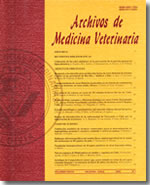Gluconeogenic capacity and energy balance in grazing dairy cows treated with a low dose of recombinant bovine somatotropin in transition period
Main Article Content
Abstract
The aim of the study was to establish the low dose effect (250 mg/cow) of recombinant bovine somatotropin (rbST) in grazing dairy cows during the transition period on energy-protein balance parameters and gluconeogenic capacity. 3 assays were conducted: Prepartum, 10 prepartum cows were used: bST group (bST, n = 5), single dose of rbST on the 26th day (d) prepartum, and control (n = 5); blood samples and body condition score (BCS) were obtained every 3d from 26thd to 6thd prepartum. Pospartum, 10 postpartum cows were used: bST group (n = 5), single dose of rbST on the 6thd postpartum, and control (n = 5); blood samples, body weight (BW), BCS and milk production were obtained and recorded every 3 days from 6thd to 27thd postpartum. Transition, 14 prepartum cows were used: bST group (n = 7), treated with rbST every 14 days from 21thd prepartum to 7thd postpartum, and control (n = 7); blood samples, BW and BCS score were obtained every 3 days from 21thd prepartum to 7thd postpartum; additionally, a propionate loading test was performed (bST, n = 4; control, n = 4) on the 9th d postpartum to assess conversion of propionate to glucose. In all the assays, energy and protein plasma concentration were determined. The treatment of grazing dairy cows with a single dose of rbST in prepartum did not change the energy balance, while in early postpartum it increased milk production without a detrimental effect on energy balance. Propionate to glucose conversion in early postpartum was not affected by the prepartum administration of rbST.

